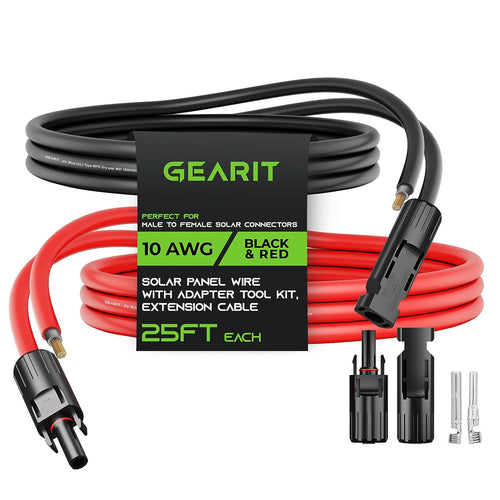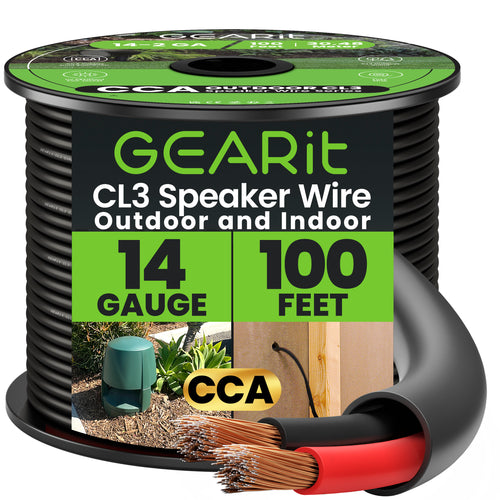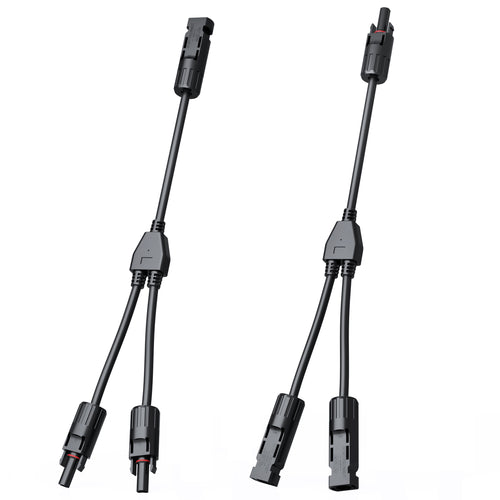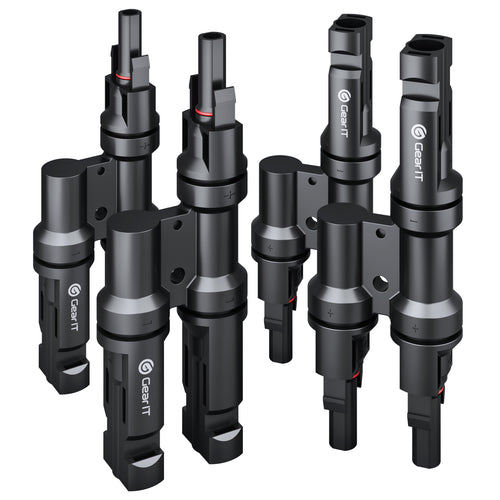The solar panel extension cable guide provides an overview of what solar panel extension cables are and their significance.
These cables connect solar panels to one another or to other devices. Using the incorrect cables can lead to issues such as voltage drop, incompatibility, or even fire hazards.
Understanding the cables used in your solar setup is essential for ensuring safe and efficient operation.
This guide covers everything from selecting the right cables to troubleshooting common issues.
This guide offers the important information you need, whether you're new to solar panels or seeking additional insights.
Solar Panel Extension Cable Guide: Why It Matters
Solar panel extension cables connect solar panels with other components like charge controllers or inverters.
Using the wrong cable can lead to power loss and overheating. These factors highlight the importance of selecting the right extension cables for efficient solar energy systems.
Understanding the Role of Extension Cables in Solar Systems
Extension cables play a crucial role in any solar setup. They connect your solar panels to essential components such as charge controllers, batteries, or inverters, allowing the power generated by the panels to reach the necessary locations.
Here’s what sets solar extension cables apart:
- Made for outdoor use – Designed with thick insulation that can withstand UV rays, rain, and other weather conditions.
- Built to handle high voltage – These cables are made to carry the electrical loads that solar systems generate, helping reduce energy loss over longer distances.
-
Boost safety and efficiency – Choosing the right cable minimizes risks like overheating and helps your system run more smoothly.
Using the correct type and size of extension cable is key to both performance and safety when installing a solar energy system.
What Happens When You Use the Wrong Cable
Using incorrect extension cables can lead to several problems:
- Voltage drop: When cables are too thin or too long, voltage drop can occur, reducing the efficiency of your solar power system.
- Power loss: Improper cables can cause significant power loss, affecting the amount of energy you receive from your solar panels.
- Overheating: Inadequate cables risk overheating, which can cause damage to components or pose a fire threat.
The right choice of cables is essential for maintaining system efficiency and safety. Use high-quality, properly sized cables to avoid these issues and ensure optimal performance.
Choosing the Right Solar Panel Extension Cable
Selecting the appropriate solar panel extension cable involves understanding your solar setup's requirements and ensuring compatibility. Key factors include wattage, cable gauge, and environmental conditions.
Step-by-Step Buying Checklist
✅️ Check Solar Panel Wattage & Current (Amps): Know the wattage and current requirements of your system to choose a cable that can handle the load. Too much current can damage undersized cables.
✅️ Measure the Exact Distance Between Components: Measure the distance from the panels to the charge controller or inverter to avoid unnecessary voltage drops caused by overly long cables.
✅️ Match the Cable Gauge (AWG) to the Current + Distance: The American Wire Gauge (AWG) rating must suit both the length and current. A thicker cable is necessary for longer distances or higher currents.
✅️ Ensure Connector Type: Verify compatibility with your system's connectors, like MC4, Anderson, or SAE, to ensure easy and secure connections.
✅️ Confirm Cable Insulation is Outdoor-Rated: Ensure the cable's insulation is designed for outdoor use. UV resistance and waterproofing are essential to withstand weather conditions.
Cable Gauge Explained: Why Size Matters
Understanding AWG (American Wire Gauge): This standard measures wire thickness. Lower numbers mean thicker wires, which can carry more current over longer distances.
Choosing the Right Gauge: A thicker wire minimizes energy loss for longer cable runs. For example, a 10 AWG cable can carry more current over a longer distance with less voltage drop compared to 12 or 14 AWG.
Comparison Example:
- 10 AWG: Best for long distances and high currents.
- 12 AWG: Suitable for medium distances.
- 14 AWG: Works for short distances with lower current needs.
Voltage Drop Calculator Reference: Calculate potential voltage drop by using tables or online tools based on your setup's specifics, ensuring efficiency in power transfer.
Types of Solar Panel Extension Cables
🛒 10AWG Solar Panel Extension Cable
Extension cables are essential for connecting solar panels to each other or to other parts of your solar power system. The type of cable you choose depends on your setup and how much power you're handling.
Here’s a breakdown of the most common types:
MC4 Extension Cables (Most Common)
MC4 stands for “Multi-Contact, 4mm.” These are the standard in most solar installations and are used in both residential and commercial systems.
- Features a locking mechanism for a secure, weather-resistant connection
- Designed to handle high voltage and outdoor conditions (UV- and moisture-resistant)
- Compatible with most solar panels and inverters
-
Durable and reliable, making them a go-to choice
Keep in mind:
- Disconnecting MC4 cables requires a special tool
- Improper installation can lead to faults or power loss
Anderson Powerpole Extension Cables
Popular in off-grid setups, RVs, and mobile solar systems, these connectors are built for high-current applications.
- Supports higher current loads than MC4 cables
- Modular design allows for flexible wiring and easy customization
- Ideal for systems that need thicker wire gauges or more power flow
Keep in mind:
- More complex to assemble
- Better suited for users comfortable with advanced setups
SAE and Other Connectors
SAE connectors are often used in portable solar kits where ease of use and quick setup are priorities.
- Simple plug-and-play design
- Great for temporary or mobile solar setups (like camping or small devices)
- Easy to connect and disconnect as needed
Keep in mind:
- Lower current rating than MC4 or Anderson connectors
- Polarity must be checked before use—plugging in the wrong way can cause damage
Installation Tips for Solar Panel Extension Cables
Installing solar panel extension cables requires careful attention to detail to ensure safety and efficiency.
Proper cable management outdoors and preventing voltage drop are essential for an effective setup.
Safety First: Outdoor Cable Management
When managing cables outdoors, start with cable clips, zip ties, and conduit to secure the cables safely. This will keep the wires organized and prevent them from tangling or damaging.
It's important to avoid sharp bends in the cables, as they can weaken the wires inside. Ensure the cables are not lying in pooling water, as moisture can lead to short circuits.
Additionally, protect the cables from UV exposure, as prolonged sun exposure can cause them to degrade over time.
Tips:
- Use zip ties to bundle cables neatly.
- Slide cables through the conduit where possible.
- Regularly inspect for wear and tear.
How to Prevent Voltage Drop
Voltage drop can impact the performance of your solar panels, so try to minimize it as much as possible.
The first step is to keep cable lengths short. Longer cables increase resistance, leading to more significant voltage drops.
Choose a thicker gauge wire. A thicker wire has less resistance and hence reduces voltage drop. Generally, 10 AWG or 8 AWG (American Wire Gauge) is recommended for longer distances.
For those with more experience, consider using parallel cable runs. This advanced technique can reduce voltage drop by distributing the load across multiple wires.
Tips:
- Opt for the shortest possible cable routes.
- Use thicker wire gauges for longer distances.
- Consider parallel runs for high-demand setups.
Solar Panel Extension Cable Guide for Different Setups
Choosing the right solar panel extension cable depends on your specific setup. Key factors include cable length, wire gauge, and connector compatibility.
These considerations help ensure efficient energy transfer and safety for various environments.
For RV and Vanlife Solar Setups
When setting up solar panels for your RV or van, consider using cables that are generally under 20 feet.
This helps minimize energy loss. A wire gauge of 10 or 12 AWG is often recommended for better efficiency in these confined setups.
Flexible cables are beneficial as they can navigate tight spaces more efficiently. Ensuring the cable is the correct length for your setup will avoid excess slack, ensuring neatness and safety.
📌 Also read: RV Power System Upgrades: Enhancing Efficiency and Reliability
For Home or Off-Grid Cabins
For home or off-grid cabin setups, longer cable runs, typically over 30 feet, are often required.
Using a 10 AWG or lower gauge ensures a safer and more efficient energy transfer over these distances.
Consider running cables through conduits for protection, particularly if they are exposed to harsh conditions.
Burying cables can also help prevent physical damage and increase the lifespan of your installation.
For Portable Solar Generators
Compatibility is crucial when using portable solar generators like those from Jackery, EcoFlow, or Bluetti. It's vital to use appropriate connectors, such as MC4 to XT60 or MC4 to DC5521.
These connectors ensure that your cables can link effectively with different generator models. Verify compatibility to maintain consistent energy flow and prevent connection issues while using portable systems.
Common Mistakes When Buying Solar Panel Extension Cables
1. Buying Based Only on Price
Choosing cables solely based on price can lead to poor performance. Cheaper cables might not be durable or efficient, leading to higher long-term costs. Invest in quality to ensure your solar setup functions well and lasts longer.
2. Using Regular Household Wire
Regular household wires are not designed for solar systems. They may not handle outdoor conditions or high currents, which can cause safety issues. Always opt for solar-specific cables to guarantee safety and efficiency.
3. Mixing Incompatible Connectors
Using connectors that don't match your system can result in poor connections and energy loss. Ensure that your connectors, like MC4, are compatible with your panels and other components for a reliable setup.
4. Ignoring Voltage Drop on 12V Systems
Voltage drop can significantly affect the performance of 12V systems. If cables are too long, they may lose power, leading to inefficiencies. Measure distances accurately and choose the right cable size to minimize losses.
5. Reversing Polarity During DIY Installations
Reversing polarity is a common DIY mistake that can damage your system. Pay close attention to the cable's positive and negative markings while connecting your setup to avoid costly errors.
📌 Also read: How to Measure Wire Gauge: Simple Tips for Beginners
Best Solar Panel Extension Cables (Top Picks for 2025)
When selecting the best solar panel extension cables for your system, it's important to consider cable type, length, connectors, and outdoor rating.
1. 10 AWG MC4 Extension Cables
- Brands: GearIT and BougeRV
- Available lengths: 10 feet, 20 feet, 30 feet
- Connector Type: MC4
- Outdoor Rating: Waterproof, UV-resistant
These cables ensure efficient energy transfer and withstand various weather conditions, making them reliable for outdoor installations.
2. Heavy-duty Anderson Cables
- Lengths Available: 15 feet, 25 feet, 50 feet
- Connector Type: Anderson
- Outdoor Rating: Weatherproof, suitable for high-power systems
Heavy-duty Anderson cables offer robust connections that are ideal for high-capacity setups, providing secure links even in challenging environments.
3. Flexible SAE Cables for Portable Kits
- Available lengths: 10 feet, 20 feet
- Connector Type: SAE
- Outdoor Rating: UV-resistant, flexible design
Designed for portability, these SAE cables are perfect for solar generators and portable kits, allowing easy setup and durable performance in various settings.
Choosing the right cable not only improves the efficiency of your solar setup but also ensures longevity and safety. Each type has distinct features that cater to different installation needs, so consider what's best for your use case.
Conclusion
Choosing the right solar panel extension cable is key when working with solar power systems. These cables extend the distance between your solar panels and other components, such as inverters or charge controllers.
Ensure your extension cable is weather-resistant to handle various environmental conditions. Look for materials like UV-resistant and waterproof coatings to prolong the cable's life.
Pay attention to the cable's gauge and length. A thicker gauge (lower number) reduces power loss, particularly important over longer distances.
Tips for Choosing a Solar Panel Extension Cable:
- Check compatibility with your solar panel connectors.
- Consider the required cable length.
- Choose cables with durable, weatherproof coatings.
- Ensure the appropriate gauge to minimize power loss.
Using the right solar panel extension cable helps in efficient energy transfer, contributing to a more reliable solar power setup. This maximizes your system's performance and ensures long-lasting use.
Check Out Related Collections 🔎
Frequently Asked Questions
When using solar panel extension cables, several common questions can help you optimize their use. Knowing the right cable length, connection tips, polarity checks, underground usage, and protection measures can ensure your solar setup works efficiently.
What is the maximum length for a solar panel extension cable?
The maximum length of a solar panel extension cable depends on the wire gauge and system voltage. In general, it's best to keep cables under 100 feet to avoid power loss. Using thicker cables (like 10 AWG or 8 AWG) helps reduce voltage drop over longer distances. Always check voltage drop calculators to size your cable correctly.
Can I connect two extension cables together?
Yes, you can connect two solar extension cables together using matching connectors like MC4. However, keep in mind that adding more length increases resistance and can reduce efficiency. Make sure the total length does not cause significant voltage drop. It’s also important to secure the connection and keep it weatherproof.
How do I check polarity on MC4 cables?
To check polarity on MC4 cables, use a multimeter. Set the multimeter to DC voltage, then place the red probe on the positive cable and the black probe on the negative. A positive reading confirms correct polarity, while a negative reading means the cables are reversed. Always double-check polarity before connecting to your system.
Is it okay to run extension cables underground?
Yes, solar extension cables can be run underground, but they must be rated for direct burial. Use cables with thick insulation and UV- and moisture-resistant jackets. It's a good idea to run them through conduit for added protection. Check local electrical codes to make sure your setup is safe and legal.
How do I protect my cables from animals or the weather?
To protect your solar cables, use conduit or cable sleeves that are resistant to chewing and moisture. Burying the cables or securing them off the ground can help keep animals away. For weather protection, choose cables rated for outdoor use with UV and water resistance. Regular inspections can also help catch any early damage.
Read Related Articles 📖
- Solar Panel Wiring: Guide on How To Wire Series & Parallel
- Solar Panel Connectors Types: A Complete Guide
- Everything You Need To Know About the 12AWG Wire




























































